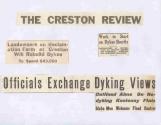15
The frantic efforts to save the dykes failed. Reclamation Farm was the first to flood, with the breach in the dykes occuring in the last week of May."The heavy pressure of flood waters at the south end of the Reclamation farm last Tuesday caused a breach in the dyke which resulted in 3,000 acres of grain being submerged."
- Creston Review, June 3, 1938.
17
"The first place I worked for the Rogers [at Reclamation Farm]. They knew that when the river came over the dykes it would come up to the edge of the windows. Everything that was on the main floor had to be carried upstairs, and that's what we did. They patrolled the dykes every day, and when it got so that it was almost to the top, then they decided, you've got to get ready to move. Finally at about noon one day, they came down and told us that by four o'clock there'd be water on the road. So, if we were going to get out, we'd better get out."- Margaret Berg
19
"An unlooked for leak in the dyke at Wynndel last Tuesday afternoon caused a total of 7,300 acres in the Creston Dyking District to be submerged. The total area now underwater is 14,500 acres. The Kootenay River valley at Creston is now flooded and the steadily rising waters continue to pound the dyke at the one remaining district of 2,200 acres on Nicks Island."- Creston Review, June 10, 1938.
21
"The leak in the Wynndel dyke occurred a quarter of a mile beyond the Wynndel pumphouse. King Hubbard and Elmer Hagen spotted the boil. During the interval when Hubbard was looking for some bags to plug the leak, an opening occurred in the dyke which the pressure from Kootenay Lake widened rapidly."- Creston Review, June 10, 1938.
23
"The flooding of these 14,500 acres of grain land will be felt in the Creston business section. It is reported that in 1937 this area produced more than a half million bushels and the prospects for this year looked even better."- Creston Review, June 10, 1938.
24
The flood of 1938 was devastating for the farmers. The loss of a year's crops exacerbated money worries for those who were still trying to recover from the bankruptcy of the Kootenay Valley Power Company in 1932. "It was like losing everything they had," says Bill Piper of his parents. The Pipers had come to the Creston Valley in 1929, left after the bankruptcy in 1932, came back and tried again in 1934, then left again after the 1938 flood. Ultimately, Mr. Piper recalls, they moved back to Creston for good, "because they had nowhere else to go. They were tough, gritty people, but it took a lot of courage."Other farmers left and never returned. Those who stayed turned their attention to repairing the dykes and starting over.
25
After the flood of 1938 plans were underway to rebuild the damaged dykes and homes.1938
Creston Valley, BC

26
"Arrangements for dyke reconstruction on the Reclamation Farm were completed at a meeting of Reclamation Farm landowners. Landowners are prepared for an expenditure of about $40,000. Along with reconstruction of the broken dykes it is planned to strengthen all exposed sections of the levee and heighten them at some locations."- Creston Review, August 5, 1938.





